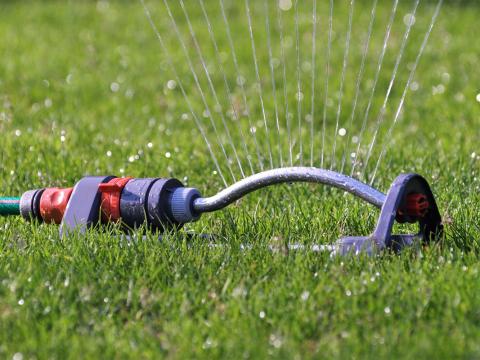Water Conservation Fundamentals in Gardening and Landscaping

Over the past few years we have experienced some extremes when it comes to the weather. There have been longer periods of little or no rain during the summer, very windy conditions and some months have been much warmer than normal. Whether you are planning a new garden or wish to make some changes in your present landscape, here are a few ideas to conserve water.
Watering
Much of the water applied to lawns and gardens is never absorbed and put to use. The water must reach a plant’s root zone in order for it to be utilized. Some water is lost as runoff when it is applied too rapidly, and some evaporates from exposed, bare soil. However, the greatest waste of water is often from applying too much irrigation too often.
Before you water, you should dig down to the root zone to find out if the soil is dry. The surface of the ground dries quickly, but insulates and slows the evaporation of the soil moisture beneath. If you find that the soil is dry around the plant’s root zone, it’s time to apply irrigation. Water slowly and deeply, making sure the water dampens the soil to a depth of at least eight inches. Just beware that excess watering can leach nutrients deep into the soil and away from plant roots, or lead to runoff that can carry fertilizers and pesticides into streams and lakes.
You should only need to water the landscape when rainfall is insufficient to maintain plant health. A general guideline for most landscape plants is one inch of water per week. To determine if the rain has provided enough, monitor it using rain gauges around the property.
Soil Analysis
Plants get their nutrients and water from the soil. If you take care of the soil, you’ll also be taking care of the plants. UNH Extension provides soil testing and nutrient recommendations to farmers and homeowners. From these recommendations you will be able to add the correct amount of organic matter if it is needed. An appropriate amount of organic matter will increase the soil's ability to absorb and store water, which results in better plant health and water conservation. Most research shows that coarse materials such as compost and composted manure are the best organic sources to improve water holding capacity.
Applying a layer of mulch will also reduce your watering needs. In nature, the soil is seldom bare. Mulch not only reduces water evaporation, but suppresses weeds and moderates soil temperature.
Plant Selection
Spend some time researching the new plants you're considering. A plant’s growing requirements should match the sun exposure and soil conditions in your yard and garden. Use drought tolerant plants to reduce water consumption in naturally dry soils. Be aware of Invasive Plants that will crowd out native plants. Select native trees, shrubs and groundcovers which are adapted to New Hampshire’s soil and climate. Many native plants have lower water demands, fewer pest problems, and need less fertilizer than other exotic landscape plants.
Lawns
Grasses require more frequent watering and maintenance than most other landscape plants and it has been documented that many lawns receive twice as much water as they require. The key to watering lawns is to do it in a manner that that water does not quickly evaporate or run-off to other areas. Watering in the early morning before the temperature rises and the wind picks-up reduces evaporation and overall water loss. Watering infrequently and deeply causes grass roots to grow further into the soil to reach soil moisture. As a result, a deep-rooted lawn is more water efficient and drought enduring. Grass wilting and discoloration are signs of water stress and will require watering in the next 1 to 2 days. Apply 1 inch of water to the lawn as rapidly as possible without runoff.
Lawn care is also important. Mowing grass at the proper height conserves water and improves its health. Try to maintain lawns at a height of at least three inches. Fertilize the lawn once in the spring with slow release fertilizer and again in the fall with a quick release fertilizer. This should result in an attractive lawn but minimize the need for extra watering due to excessive growth.
Trees and Shrubs
All trees and shrubs need frequent watering from the time they are planted until they become well rooted, which may take two growing seasons. Established trees, shrubs and groundcovers may be watered more infrequently. As with the lawn, trees and shrubs should be watered deeply to establish a deep root system which is more water efficient. The feeding root system of a tree or shrub is located within the top 12 inches of the soil and at the area directly below the outermost reaches of the branches, commonly called the dripline. Apply water to a depth of 8 to 10 inches just inside and a little beyond the dripline, not at the trunk.
UNH Cooperative Extension Master Gardener volunteers share information about home, yard, and garden topics with the people of New Hampshire. Got questions? Master Gardeners provide practical help finding answers to your questions through the Ask UNH Extension Infoline. Call toll free at 1-877-398-4769, Monday to Friday, 9 a.m. to 2 p.m., or e-mail us at answers@unh.edu.
Related Resource(s)
Do you love learning about stuff like this?
SUBSCRIBE TO Granite State Gardening newsletter
Got questions? The UNH Extension Yard and Garden Infoline offers practical help finding answers for your yard and garden questions.
Call toll free at 1-877-398-4769, Monday to Friday, 9 a.m. to 2 p.m., or fill out webform.

